IoT remote monitoring: Definition, How it Works and Applications
The IoT remote monitoring is about using interconnected devices and sensors to collect and transmit data from remote assets or environments. These assets may include machinery....

Introduction to IoT remote monitoring
In the ever-evolving landscape of technology, the Internet of Things (IoT) has emerged as a transformative force, reshaping the way we connect, communicate, and interact with our surroundings. Among the many uses of IoT, remote monitoring is one that stands out for having a big influence on enterprises and industries.
Defining IoT remote monitoring:
At its core, IoT remote monitoring involves the use of interconnected devices and sensors to collect and transmit data from remote assets or environments. These assets can range from machinery and equipment to environmental conditions and beyond. The goal is to enable real-time monitoring, analysis, and management of these assets, fostering increased efficiency, proactive decision-making, and improved overall performance.
The core components of IoT remote monitoring systems
To truly grasp the functionality and significance of IoT remote monitoring, it's essential to understand the integral components that work in harmony to facilitate seamless data acquisition, transmission, and analysis. The effectiveness of these systems depneds on the synergy between these key elements:
Sensors and data collectors:
At the heart of any IoT remote monitoring system are the sensors or data collectors. These devices are strategically deployed to capture real-time information from the environment or the asset being monitored. Whether it's temperature, pressure, vibration, or other relevant metrics, sensors act as the frontline data gatherers, transforming physical signals into digital data.Communication devices:
Once data is collected, it needs a means of transportation to reach the central processing unit or cloud-based platform for analysis. Communication devices, often utilizing wireless protocols like Wi-Fi, Bluetooth, or cellular networks, play a crucial role in transmitting the acquired data securely and efficiently. The choice of communication technology depends on factors such as range, bandwidth requirements, and power consumption.Central processing unit or cloud platform:
The collected data is then sent to a central processing unit (CPU) or a cloud-based platform where the magic happens. Here, sophisticated algorithms and analytics tools process the incoming data, extracting valuable insights. Cloud platforms, in particular, offer scalability, flexibility, and accessibility, allowing stakeholders to access information from virtually anywhere in the world.User interfaces:
The end result of the entire process is presented to users through intuitive and user-friendly interfaces. These interfaces can take various forms, including web-based dashboards, mobile applications, or specialized software. They provide a comprehensive overview of the monitored assets, offering real-time data visualization, historical trends, and customizable alerts.Actuators (optional):
In certain scenarios, IoT remote monitoring systems may include actuators, which are devices capable of responding to the insights gained from the data analysis. For example, an actuator could be used to adjust environmental conditions based on the sensor readings, automating processes and optimizing efficiency.
How does IoT remote monitoring work?
It operates through a network of interconnected devices and sensors strategically positioned to capture real-time data. These sensors, equipped with various technologies, meticulously observe and collect information, such as environmental conditions or machinery performance.
Upon data capture, wireless communication devices swiftly transmit it to a central processing unit or cloud-based platform. Here, sophisticated algorithms analyze the information, extracting meaningful insights and identifying patterns. The processed data is then presented to users through intuitive interfaces like web-based dashboards or mobile applications, offering real-time updates and historical trends.
Automation plays a role in certain scenarios, where predefined conditions can trigger immediate responses. For instance, detecting irregularities in machinery temperature could prompt automated alerts or corrective actions through connected actuators.
The brilliance of IoT remote monitoring lies in its continuous feedback loop. As sensors collect real-time data, the system processes and presents insights, creating a dynamic cycle that empowers organizations to proactively address issues, optimize processes, and make informed, real-time decisions.
Understanding this process unveils the potential for IoT remote monitoring to revolutionize industries, enhance operational efficiency, and contribute to a more connected and intelligent business landscape.
Real-world applications of IoT remote monitoring
IoT remote monitoring isn't just a concept; it's a tangible force driving efficiency across various industries. Here's a quick look at some real-world applications:
- Manufacturing: Enhancing production efficiency by monitoring machinery health, predicting maintenance needs, and minimizing downtime.
- Healthcare: Improving patient care with real-time tracking of medical equipment, ensuring optimal conditions, and streamlining logistics.
- Agricultural: Optimizing crop yields by monitoring soil conditions, weather patterns, and equipment performance in real-time.
- Energy: Maximizing energy efficiency through continuous monitoring of equipment, detecting faults, and optimizing energy consumption
- Smart buildings: Ensuring comfort and energy efficiency by monitoring HVAC systems, lighting, and security in real-time.
- Logistics: Enhancing visibility and reducing inefficiencies by tracking shipments, monitoring storage conditions, and predicting delivery times.
- Fleet management: Optimizing vehicle performance, ensuring driver safety, and improving fuel efficiency through real-time monitoring.
These examples illustrate how IoT remote monitoring is a practical solution, providing actionable insights and driving positive outcomes in diverse sectors.
Benefits of IoT remote monitoring systems
Incorporating IoT remote monitoring systems into your business operations brings forth a spectrum of advantages, transforming the way you manage assets, monitor processes, and make critical decisions. Here's a more detailed exploration of the key benefits:
1.) Operational efficiency improvement:
By providing real-time insights into various aspects of your operations, IoT remote monitoring facilitates a more significant understanding of workflows. This, in turn, allows for the identification and elimination of inefficiencies, leading to a significant improvement in overall operational efficiency.
2.) Cost reduction through predictive maintenance:
One of the standout advantages of IoT remote monitoring is its ability to enable predictive maintenance. By continuously monitoring the health and performance of equipment, the system can predict when maintenance is needed, reducing downtime, extending the lifespan of assets, and ultimately lowering maintenance costs.
3.) Enhanced safety measures:
Real-time monitoring of environmental conditions and equipment performance contributes to a safer working environment. Immediate detection of potential hazards allows for prompt intervention, mitigating risks and ensuring the well-being of employees.
4.) Data-driven decision making:
The wealth of data generated and analyzed by IoT remote monitoring systems empowers organizations to make informed, data-driven decisions. Whether it's optimizing processes, resource allocation, or strategic planning, having actionable insights at your fingertips enhances decision-making processes.
5.) Proactive issue resolution:
Early detection of anomalies and potential issues is a game-changer for businesses. The ability to address problems before they escalate minimizes disruptions, prevents costly breakdowns, and contributes to a more stable and reliable operation.
6.) Optimized resource utilization:
Efficient use of resources, be it energy, raw materials, or manpower, is a crucial aspect of sustainability and cost savings. IoT remote monitoring systems provide the visibility needed to optimize resource utilization, leading to reduced waste and improved efficiency.
7.) Customizable alerts and notifications:
Tailored alert systems allow organizations to set up specific parameters and conditions that, when met, trigger instant notifications. This customization ensures that relevant stakeholders are promptly informed of critical events, enabling quick responses and preventive actions.
8.) Remote accessibility:
Cloud-based platforms used in IoT remote monitoring systems offer the advantage of remote accessibility. This means that stakeholders can monitor and manage operations from anywhere, providing flexibility and enabling more efficient management, especially in a globalized business environment.
9.) Increased productivity:
Reduced downtime, automated processes, and efficient monitoring contribute to an environment that fosters increased productivity. With systems in place to address issues swiftly, employees can focus on value-added tasks rather than troubleshooting problems.
10.) Competitive advantage:
Embracing IoT remote monitoring positions businesses at the forefront of technological innovation. This not only provides a competitive edge but also fosters adaptability in an ever-evolving business landscape, ensuring long-term sustainability and growth.
Key challenges and solutions in IoT remote monitoring
Implementing IoT remote monitoring systems is not without its challenges. Ensuring the security of transmitted data, managing the sheer volume of information generated, and addressing compatibility issues between diverse devices are among the hurdles faced. However, advancements in encryption technologies and the implementation of robust cybersecurity measures have alleviated many security concerns.
Additionally, data analytics tools and machine learning algorithms have evolved to handle large datasets efficiently, extracting meaningful insights. Collaborative industry efforts towards standardization further contribute to overcoming compatibility challenges, ensuring a more seamless integration of IoT remote monitoring systems across various platforms. While challenges persist, the industry's commitment to innovation and collaboration continues to drive solutions, making IoT remote monitoring an increasingly accessible and effective solution for businesses across diverse sectors.
Choosing the right IoT remote monitoring solution
Selecting the most fitting IoT remote monitoring solution is a pivotal decision for businesses aiming to harness the benefits of this transformative technology. The process involves careful consideration of several factors:
- Scalability: A scalable solution can adapt to the evolving needs of your business. Ensure the chosen IoT remote monitoring system can seamlessly grow with your operations.
- Integration capabilities: Compatibility with existing infrastructure is crucial. Opt for a solution that integrates smoothly with your current systems to avoid disruptions during implementation.
- Security measures: Prioritize robust security features. Encryption protocols, secure data transmission, and access controls are vital components to safeguard sensitive information.
- Data management and analytics: Look for solutions equipped with advanced data management and analytics capabilities. The ability to process and derive actionable insights from the collected data is essential for informed decision-making.
- Reliability and performance: Assess the reliability and performance of the solution under various conditions. A dependable system ensures consistent monitoring and timely responses.
- User-friendly interfaces:Intuitive and user-friendly interfaces enhance the accessibility and usability of the system. Ensure that stakeholders can easily navigate and interpret the presented data.
- Cost considerations: Evaluate the total cost of ownership, including upfront costs, ongoing maintenance, and potential scalability expenses. Choose a solution that aligns with your budget constraints while providing long-term value.
- Vendor reputation: Research the reputation of the solution's vendor. Consider factors such as industry experience, customer reviews, and the vendor's commitment to ongoing support and updates.
- Flexibility and customization: A flexible solution allows for customization based on your specific requirements. Look for systems that can adapt to the unique needs and challenges of your business.
Conclusion:
In wrapping up, the process of selecting the optimal IoT remote monitoring solution demands a strategic and thorough approach. Ensuring that the features and capabilities of a solution align seamlessly with the unique needs of your business is pivotal for unlocking the full potential of IoT remote monitoring. As technology evolves, staying abreast of the latest advancements and collaborating with reputable vendors will position your business for sustained success in the ever-expanding landscape of remote monitoring solutions, particularly with the integration of cutting-edge IoT software. This strategic alignment not only streamlines current operations but also lays the foundation for innovative solutions that leverage advanced data analytics and smart technologies.
